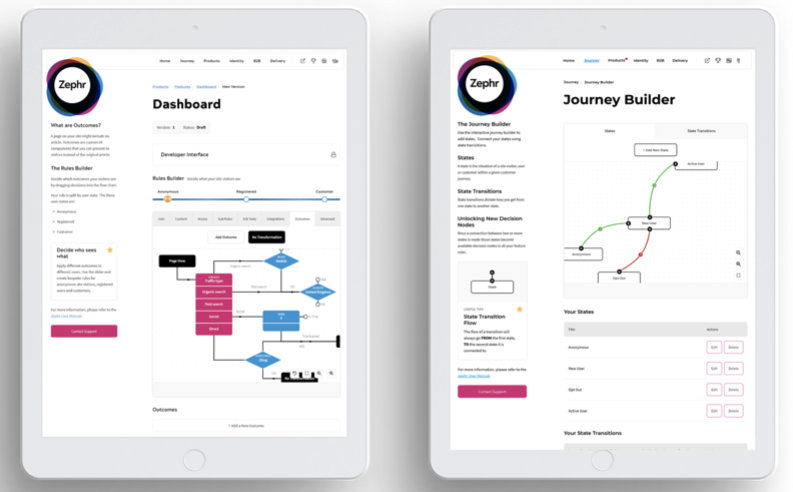|
Getting your Trinity Audio player ready...
|
Turning casual browsers into followers, or ultimately into subscribers, is a challenge facing publishers in every sector of the media. Startup Zephr, which last year received a significant injection of venture capital, is pioneering customer journey solutions that are rooted in technological innovation.
Here COO, Felix Danczak, details how the company has grown and how he believes that personalisation and optimisation are the key to successful sales.

So tell me a little about the history of Zephr? When were you set up? What are the key challenges you are trying to address?
Zephr has been operating since 2017 (It was renamed Zephr in 2019, it was previously called Blaize). The business was bootstrapped by James Henderson, the CEO, and in 2019 took GBP£2.3M (USD$2.9M) in funding from Nauta Capital, a venture capital fund. We have grown 3x in the last 12 months and continue to scale at pace – growing the team from 20 to 35 today (and still growing!). Zephr helps media and digital businesses to gear up for the fast-growing subscription economy. Over the years it’s been very tech and code heavy to create new customer experience and journeys. Zephr enables the business to be closer to the product, easily creating high-conversion user journeys, rapidly building stronger customer relationships and dramatically boosting retention rates and revenues.
What makes Zephr different from your rivals?
Zephr is a best-of-breed driven company, specifically focused on customer journey orchestration, identity and access. We’re a very innovation focused company, driven by our product and engineering teams with over 75 per cent of the employees in these areas. That, mapped with our very simple no-code user interface, and delivery via the edge, enables marketing, business and commercial teams to drive new experiences and journeys through our browser based UI.
And can give you some examples of who you are working with and what the results have been?
We’re working with the likes of Dennis Publishing, NewsCorp, Condé Nast, MIT Technology Review and New Scientist – as well as FIPP actually! A global B2C company can attribute a 23 per cent increase in subscriptions down to using Zephr’s platform, whilst another large B2C publisher moved over 50 per cent of their audience from unknown to known (registered) in six months by testing, deploying and iterating new customer journeys to increase conversion rates.

You recently expanded out of the UK to offer your services in Europe and the US. Are there differences in the way that people consume content and the role of paywalls in the different territories. Or is it all roughly the same?
There are absolutely differences, but I don’t think this is necessarily down to geography, it’s down to the content and value exchange. We’re a big advocate of personalisation, and ensuring you put the right product, in front of the right person, at the right time, which is going to help increase your conversion rates. I guess there’s some misconceptions too, like a failure to collect, understand, interpret and leverage data appropriately in content-rich environments would represent a missed opportunity. That transition from unknown to known and on to subscribed opens up a world of possibilities and chances to drive greater value from a hard-won audience.
What role does AI play in your product?
Machine learning has a huge role to play in opening up what we can really do with journey orchestration. Today, the number of journeys, packages and products you create is limited to a human scale, but with our new dynamic product AI, you can have a truly 1:1 relationship with each and every subscriber. It means that everyone gets the experience they want, at a fair price point. Reinforcement learning modules that we are launching in the next few months will allow our customers to optimise every interaction and drive impressive growth.
How do you think media paywalls will evolve in the coming years? Is there a hybrid model likely to emerge – what seems to be the optimum product?
We believe there will be a hybrid model, but essentially very personalised and optimised. Everyone has a different value exchange, value of content, version of content and approach to converting users to their paid offerings. However, what we’re seeing more and more is the unbundling and bundling of products and approaches to ensure the right product is in front of the right person at the right time. This will be key.
Explain how you are working with FIPP?
Zephr has been a FIPP partner for a few years now. We’ve been part of FIPP’s events, insight reports (like How to Start with Paywalls and How to Start with Subscription Boxes) and the World Media Congress. However, we are also now working with FIPP on controlling access and identity for the recently re-launched website – which is going to help drive value in membership for publishers globally including access to on demand webinars, content, events and lots of great articles.
What’s next for Zephr?
Our future is bright. We’re already on track to break out targets in the next 12 months, and the AI components we’re bringing out will be a game-changer for the publishing and media industries. As we grow into maturity in those markets, we’re looking into the next big subscriber industries like SaaS and Telco. It’s such an exciting time!
Ashley Norris


